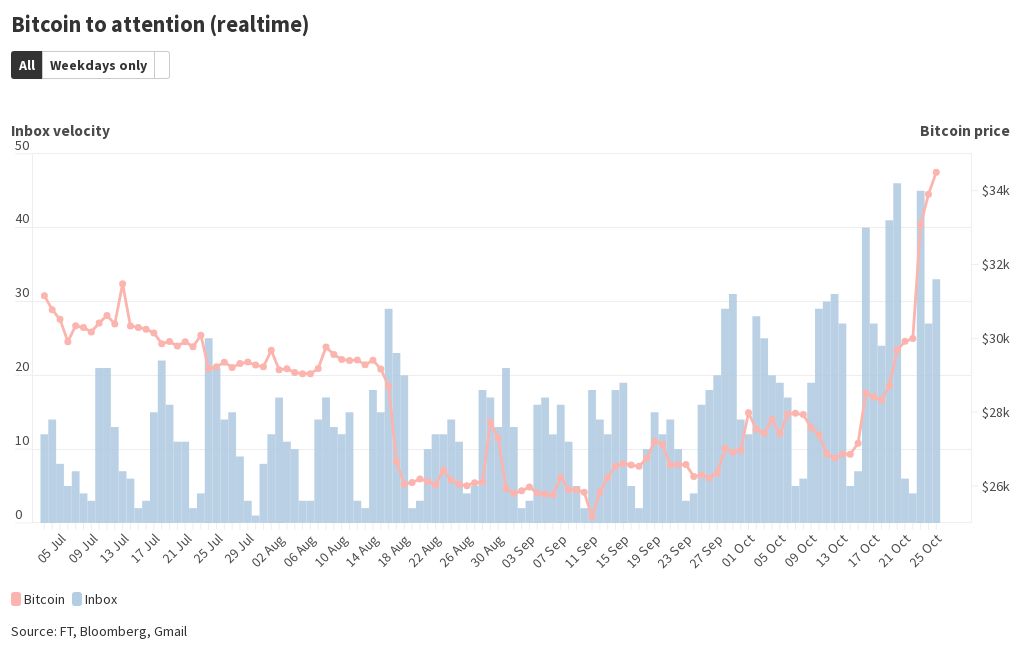Imaginary bitcoin ETFs are already 30 times more valuable than all the actual bitcoin ETFs

Roula Khalaf, Editor of the FT, selects her favourite stories in this weekly newsletter.
Crypto works a little like Candyman: say the name often enough and something might appear from nothing.
This not-particularly-virtuous circle of token prices and attention seeking is a thing we talk about quite often. A year ago, for example, it somehow became a matter of international importance that ethereum was going to change its blockchain validation method:
Why are we all talking about it? The usual reason: crypto values correlate with publicity. Social media noise can push token prices around (Tandon et al), but not as effectively as mainstream media coverage (Coulter). The most powerful crypto price accelerant is a positive-sounding theme from an influential source that’s encouraging to a silent majority (Mei et al). It’s therefore directly in the interests of ethereum whales (Coinbase, Binance, Kraken etc) to make The Merge seem like a very big deal, and we in the generalist press have been happy to oblige.
This year’s ethereum Merge is the spot bitcoin ETF.
Two months ago a US judge said it was “arbitrary and capricious” that the SEC allows bitcoin futures ETFs while blocking ETFs that hold bitcoin. The ruling will probably force the SEC to approve spot bitcoin ETFs because its only other option, withdrawing previous approvals of futures ETFs, would be even more embarrassing.
The SEC’s defeat has been portrayed as a huge deal for bitcoin, whose price correlates reasonably well with how often people say bitcoin. The below chart shows the dollar spot price alongside volumes of Google searches for bitcoin and articles mentioning bitcoin:
And for a real-time measure, chart two shows the bitcoin spot price versus the number of emails in the author’s inbox that reference bitcoin:
Since August 28, the day before the SEC lost, bitcoin has added $168bn in market cap. Bitcoin’s 32 per cent gain over the period far exceeds that of gold (+3.7 per cent), the Nasdaq Composite (-6.5 per cent) and ethereum (+14.4 per cent, probably on hopes of US regulators becoming friendlier to crypto), so the main driver does appear to be ETF hype.
To put $168bn in context, there’s $198bn currently invested in spot gold ETFs.
So are retail punters drinking the crypto Kool-Aid again? Apparently not. Recent bitcoin demand looks to be institutional, according to JPMorgan. While attention measures like the Google Trends score have been flatlining since crypto winter, open interest in CME bitcoin futures contracts (used mostly by institutional investors) has spiked back to levels last seen in August 2022 before the collapse of FTX.
JPMorgan also highlights a recent tick higher in on-chain transfers from small wallets to big ones, as shown by the below chart. Bitcoin flow tends to go towards the big wallets when there’s something positive-sounding for institutions to advertise — such as the launch of the first US futures ETF in 2021 and the halving event of 2020 — then reverses after stuff blows up:

Recent bitcoin demand therefore looks like preparatory work for the ETF marketing blitz. And because buying makes the price go up, it’s preparation that’s self-propelling.
The SEC has until January 10 to respond to a joint application from Ark Invest and 21Shares, though no one in the industry seems to expect it to take that long. Grayscale and BlackRock have made formal registrations to launch spot ETFs and here’s a flow of filings amendments, indicating back-and-forth between the regulator and asset managers to work out who can hold what.
It’s likely, says JPMorgan, that the SEC will issue mass approval notices to avoid gifting any manager a first-mover advantage.
The main benefit of a spot ETF is that it’s a more direct form of ownership than a synthetic fund, whose reliance on derivatives can introduce lag and hedging risk. A cleaner structure is nice, but to any prospective buyer of a bitcoin ETF it might not matter all that much. No one buys crypto for its simplicity.
Nikolaos Panigirtzoglou, of JPMorgan’s global markets strategy team, has called the spot advantage “rather marginal” and “unlikely to be a game-changer for crypto markets”.
Panigirtzoglou also highlights the lack of interest in spot bitcoin ETFs that already exist.
We’ve found 29 bitcoin ETFs globally that could reasonably be described as active, as well as 11 exchange-traded notes and 11 exchange-traded commodities. (Here’s an explainer of what those letters mean, the essence of which is that ETFs are equity instruments and the other two are more like debt. For the purposes of this exercise we’re bunching them together.)
Across the entire group there’s $5.6bn in fund assets. Of that total, approximately $3.1bn is in funds that are (or say they are) physically backed by bitcoin. The remaining $2.5bn is in synthetic funds/mystery boxes.
Here’s a clickable breakdown by value, type and provider. Note however that for many smaller funds, and a few of the larger ones, the replication method wasn’t made clear in the fact sheet; let us know about any errors.
Another useful measure is shares outstanding. Because ETFs are open-end funds, their share counts give an indication of demand that’s independent of asset value.
The below chart shows shares in issue for the Purpose physical ETF (in its unhedged Canadian dollar flavour) alongside ProShares’ synthetic ETF. Purpose enjoyed a rush of interest around the launch, followed by two years of nothing much:
We’re being told a lot that US-listed spot bitcoin ETFs will be revolutionary for institutional ownership of crypto. Going by the historical demand illustrated above, they probably won’t even be revolutionary for ETF providers. Chances are that by next year it'll all be forgotten, by which time there will be another bitcoin halving event to look forward to.
But when there’s a whole new market to cantillate into existence, who has time to look backwards?




Comments